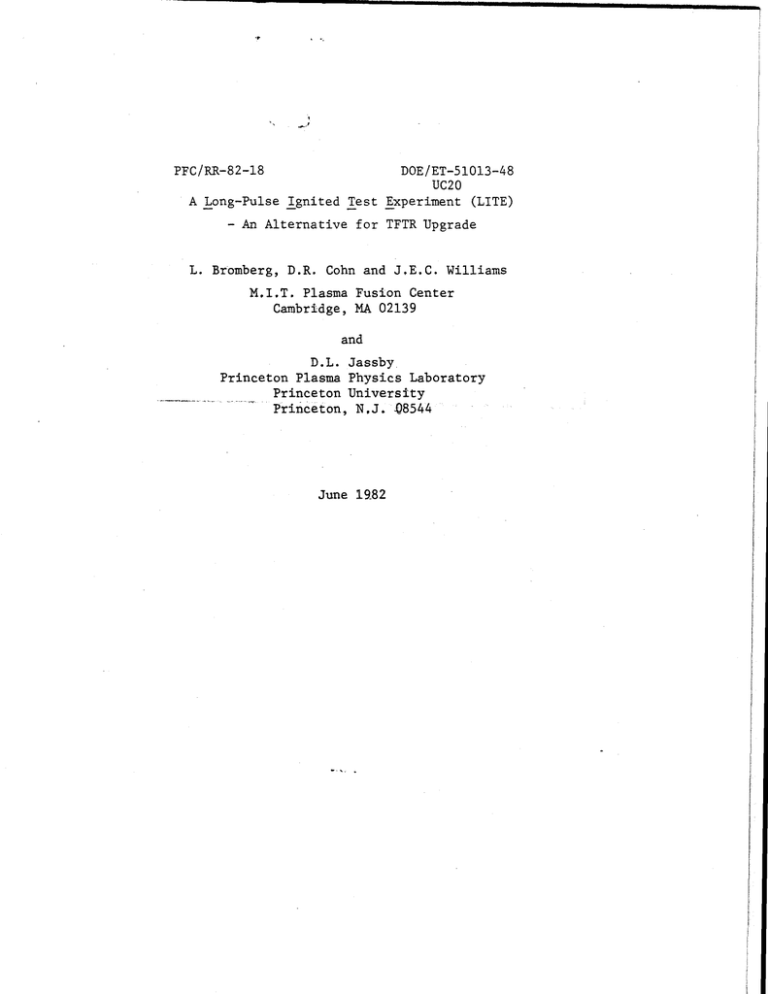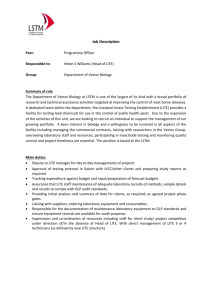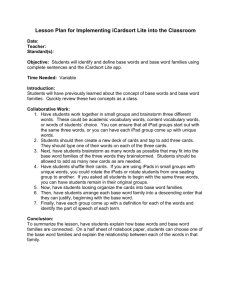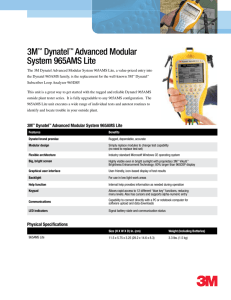PFC/RR-82-18 An Alternative for TFTR Upgrade J.E.C.
advertisement

PFC/RR-82-18 DOE/ET-51013-48 UC20 A Long-Pulse Ignited Test Experiment (LITE) - An Alternative for TFTR Upgrade L. Bromberg, D.R. Cohn and J.E.C. Williams M.I.T. Plasma Fusion Center Cambridge, MA 02139 and D.L. Jassby Princeton Plasma Physics Laboratory Princeton University Princeton, N.J. 8544 June 1982 ABSTRACT By using high performance resistive magnets it is possible to design a relatively compact tokamak which could achieve ignition, provide long pulse operation with ing. Qp 5 and advance fusion engineer- This device could be built at the TFTR site at relatively moder- ate cost, Illustrative features for this type of device, referred to as LITE for long-pulse ignited test experiment, are described, Forced flow liquid nitrogen cobling at constant temperature is used to minimize the TF magnet power requirements, Illustrative parameters are a major radius of 2,7m, a maximum magnetic field on axis of 8.8T, and an average beta of 0.044, Capability for long pulse operation at or near ignition could be provided by a relatively compact tokamak device which uses high performance magnets.1 This device could be built at relatively moder- ate cost by taking advantage of existing facilities at the TFTR site. We refer to this device as LITE for long-pulse ignited test experiment. In this paper we describe possible features for LITE. Objectives The physics objectives of LITE would include: * Demonstration of ignition 0 Demonstration of a long pulse ( with 30 seconds) controlled burn Q > 5 (nearly ignited operation with alpha particle dominated heating) 0 Study of confinement at high temperatures which can only be achieved by means of alpha particle heating. * Development of steady state current drive capability at Q ) 1, The engineering objectives would include: * Demonstration of repetitive (possibly high-duty factor) long pulse operation in hydrogen or deuterium. * Demonstration of maintenance features which are improved relative to TFTR 0 Provision of capability for high flux blanket testing. Magnet Features LITE would use a copper toxqidal field (TF) magnet of Bitter plate construction, High performance TF magnet operation is facilitated by the Bitter design in a number of ways: 0 The plates are stiff in the direction of the principal in-. plane stresses, -2- 0 The large amount of conductor minimizes magnet heating and resistive power requirements. * The current path around the ports can be chosen to minimize ripple, thus permitting large ports in a compact device. * Longer insulation life may be possible because planar insulation can be used and the stresses on the insulation are almost exclusively compressive. In the design concept considered here, the magnet would utilize forced flow liquid nitrogen cooling at constant temperatures. Liquid nitrogen operation substantially reduces the resistive power requirements (at 90* K the resistance of copper is about seven times lower than that at room temperature). The pressurized liquid nitrogen that cools the device is run through a heat exchanger that boils liquid nitrogen at 77' K. to The advantages of forced flow magnet operation relative linertially cooled operation (where the magnet temperature is allowed to rise to some limiting value as in Alcator C and in the ZEPHYR design ) are reduced peak power requirements and continuous opera- tion. The actual electrical energy requirement for liquid-nitrogencooled magnets is more than that for room temperature magnets. How- ever, most of this energy is consumed at very low power by liquifying large volumes of nitrogen when the tokamak is not operating. The low TF magnet power (<75 MW) would be provided either by motor generator sets or by drawing directly upon the electrical grid. Maintenance of LITE would be facilitated by total modularization of the tokamak system into eight octants, Illustrative Design Illustrative design parameters have been developed by extrapolating from a design developed for a compact version of the fusion engineering device 2, FED-R2, and from the ZEPHYR and AFTR designs.1 -3- The parameters are shown in Table 1. LITE would differ from FED-R2 in significantly increased ignition margins, capability for operation at higher fields, use of liquid nitrogen cooling, reduced shielding and reduced capability for blanket testing. Figure 1 shows an elevation view of the type of magnet design that would be used in LITE. Channels are provided in each plate for liquid nitrogen cooling. Keys are used to prevent slippage due to out-of-plane forces and to support the vertical loads. Figure 2 shows a side view. Sixteen side ports provide approx- imately 10m2 for heating, pumping, diagnostics and removal of blanket test modules. Figure 3 superimposes an elevation view of the TF magnet for the illustrative LITE design with the TF magnet for TFTR. Table 1 shows two modes of operation of the illustrative LITE design. Also shown is the maximum level of TFTR performance with a peak field on axis of 5T, an average beta of 0,03, and a pulse length of about 1.5 sec, (This pulse length is determined by subsystems other than the TF magnet, which would have a pulse length of about 3 sec,) For nominal LITE operation the power requirement of the steadystate-cooled TF magnet would be about 45 MW at a temperature of 90' K. The deliverable electrical energy from the two TFTR motor generator flywheel (MGF) sets (4.5 GJ) plus one additional set (2,25 GJ) should be sufficient to provide the energy needed for startup and for sustaining an ignited or.high Qp burn for several tens of seconds, including the requirements of all magnet, plasma heating, and pumping systems. The volt-second limit of the OH drive allows pulses of the order of 100 seconds. For a machine on-time of -about 1% (eig. a 30-second pulse every 15 minutes for 8 hours), the power requirement for the nitrogen liquifier would be about 20 MW. For nominal operation the membrane stress is 170 MPa. Plasma Performance Because of uncertainty in confinement scaling laws it is difficult to project values of nT for various plasma conditions. -4- However, we can develop some useful frames of reference. Since the illustrative LITE design has about the same physical dimensions as TFTR the difference in nT will result mainly from differences in average density n and current I. If we make the pessimistic assumption that the energy con- finement time, T, does not improve with n and I then (nT)LITE /(nT)TFTR ze nLITE nTFTR If on the other hand, T - n, as is used in INTOR scaling, then (nT) LITE /(nT) TFTR InT 2 LITE LITE' -,,n2 Table 1 gives the margin of ignition, MI, for INTOR scaling for TFTR and LITE. (nt)INTOR/(nT)IGNITION at T = 10 keV). (MI For the peak performance case (Bt = 8.8T) LITE has a value of MI = 5.2, which is about 17 times that possible with peak performance from TFTR. Even in the pessimistic case where T is independent of n and I, LITE would have a value of nT about 4 times larger than that of TFTR at peak performance. Use of TFTR Facility LITE has approximately the same dimensions as TFTR. For maximum cost savings, LITE would be located in the TFTR Test Cell, on the same 2 m thick steel and concrete platform presently used by the TFTR. Table 2 lists the major TFTR subsystems that LITE would make use of. The replacement value of these subsystems is at least $200 million (1982). In addition, the LITE facility would require a 3rd MGF set, modification of the neutral beam injectors for long-pulse operation or replacement by RF systems, upgrading of the tritium subsystems, and a substantial new nitrogen liquifier. Summary The illustrative LITE design concept described herein indicates the promise of this type of device for demonstrating the basic scientific feasibility requirement for.electricity production from fusion (sustained high Qp), and for advancing burning plasma physics and fusion engineering at moderate cost, A range of variations about this design concept are possible and should be explored in order to maximize its potential utility. -5- I References 1. D.R. Cohn, L. Bromberg, J.E.C. Williams, H. Becker, R. LeClaire and T. Yang, "Near Term Tokamak Reactor Designs with High Performance Resistive Magnets", presented at the IAEA Third Technical Committee and Workshop on Fusion Reactor Design and Technology, Tokyo, Japan, October (1981), MIT Plasma Fusion Center Report PFC/CP-81-29. 2. H. Becker, E. Bobrov, L. Bromberg, D. Cohn, N. Diatchenko, R. LeClaire, J. Williams, "Compact, Low Cost Option for FED: FED-R2", presentation at FED Review, Oak Ridge, National Laboratory, May 1982, report in preparation. Acknowledgment The authors would like to thank E. Bobrov, J. Powell, H. Becker and R. Davidson for very useful discussions and N. Diatchenko for the illustrations. 6 Table 1 Machine Performance of Illustrative LITE Design Peak Op. Nominal Op. TFTR Peak Performance major radius (m) 2.7 2.7 2.5 minor radius (m) 0.75 0.75 0.85 magnetic field on axis (T) 8.8 7.0 5.0 plasma elongation 1,2 1.2 1.0 average beta 0.044 0.044 0.030 5.5 3.4 1.2 2.5 4.4 3.5 3.0 margin of ignition (INTOR scaling) 5.2 2.0 0.3 neutron wall loading (MW/m2 8,6 3.3 0.7 fusion power (MWth) 960 370 TF magnet weight (tonnes) 1,600 1,600 TF magnet power for steady state operation (MW) 75 45 IF magnet stored energy (GJ) 2.8 1.8 max membrane stress in TF magnet plates (MPa) 270 170 pulse length limit from OH drive capability (seconds) 15 100 average density (10 current @ q = 14 -3 ) cm D-T burn-seconds during lifetime 73 650 1.3 - 1.5 105 total inboard shield thickness (cm) 10 10 0 outboard blanket/shield thickness (cm) 40 40 between TF coils only Table 2 TFTR Subsystems That Can Be Utilized by LITE (Listed in approximate order of capital cost) 1. Building and Utilities 2. MGF Sets and Power Conversion Equipment 3. Instrumentatin4,Control System and Computers 4. Neutral Beam Injectors and Power Supplies 5, Tritium Subsystem 6. Shielding 7. Vacuum Pumping Systems 8. Water Cooling Systems and Water Towers FIGURE CAPTIONS Figure 1: Elevation view of the TF magnet design concept showing cooling channels and keys. For the illustrative design parameters given in Table 1 there would be less elongation than shown in this figure. Figure 2: Side view of LITE. Figure 3: Superposition of an elevation view of the TF magnet for the illustrative LITE design with the TF magnet for TFTR. - F:EC0YL COOkN PAT H Z.7 y V\ ELEVAT\ON CRO & - ECT 0N FIGURE 1 PLATE. -i A. - - -4-- Fri K 01 0 -n Fl FIGURE 2 1< 2.~7 m. TFTR LITE FIGURE 3 TF TF COIL COI L PFC/RR-82-18 DOE/ET-51013-48 UC20 A Long-Pulse Ignited Test Experiment (LITE) - An Alternative for TFTR Upgrade L. Bromberg, D.R. Cohn and J.E.C. Williams M.I.T. Plasma Fusion Center Cambridge, MA 02139 and D.L. Jassby Princeton Plasma Physics Laboratory Princeton University Princeton, N.J. 08544 June 1982




